Ive done tutorials on drying fruit, making jerky and drying herbs in a dehydrator before. Some fruits dont lend themselves to drying too well rhubarb (goes stringy), gooseberries (thick skin) and raspberries (turn to mush). They can be dried though as a fruit leather. These are those strange stretchy frit things that kids love (winders etc.). This tutorial will show how to make them.
Before you start, line the trays of your dehydrator unless you have specialist leather trays. The fruit will drip through the mesh of open trays. I use microwaveable cling film but aluminium foil would work I should think. Make sure you make holes where all the air vents should be.
Step 1 gather your fruit.
For each tray of my dehydrator I need about a litre (quart) of fruit clearly for something like rhubarb this needs to be chopped. So step one is a wander round the veg patch and see whats in surplus
Rhubarb
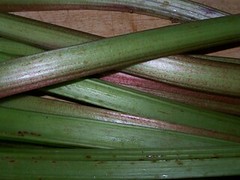
Raspberry

Gooseberry
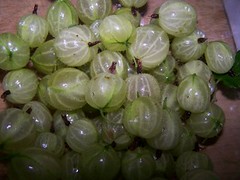
Step 2 Prepare the fruit
Its a good idea to was all the gathered fruit as the low temperatures we will use may not kill any nasties. Ultimately we will be putting all the fruit through a blender but we need to get it soft if it isnt already. A wash will suffice for the raspberries but the rhubarb needs to be chopped into ½ slices
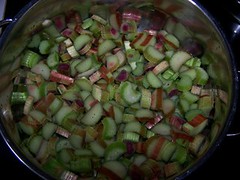
And the goosegogs topped and tailed
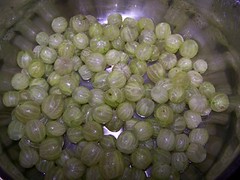
Step 3 soften if necessary
The harder fruits need to be softened before pureeing. The raspberries need nothing but the gooseberries and rhubarb need to be put into a pan with a TINY amount of water (less than a quarter cup) and heated gently just until they are soft
One softened if necessary put your fruit into a blender. If you dont have a blender you can crush the fruit with a fork in a mixing bowl. I add two tablespoons of honey to each litre of fruit I find this helps in bind into a good leather. Others use apple with soft fruit since the pectin helps the leather set either is good.


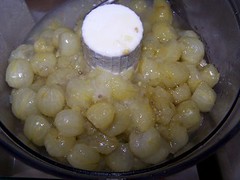
Step 4 puree
If you have a blender, slap the lid on and give the fruit a good whiz up. If not, use a fork back against the side of the bowl. You are going for porridge like consistency here

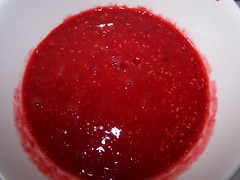
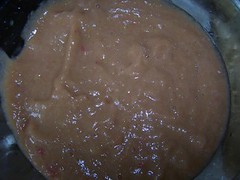
After this, if you want to remove seeds and pips, push the puree through a sieve with the back of a spoon. I like the seeds in so I dont bother but its up to you
Step 5 load dehydrator
Dont forget to ensure you have prepared your dehydrator trays with a covering if they are the mesh type.
Using a palette knife or spoon, spread you puree evenly over the trays. Aim to go no more than ¼ thick or youll be drying the stuff till the next ice age
Dont get the puree too near the air holes as it will spread a bit and you dont want it dripping through the holes
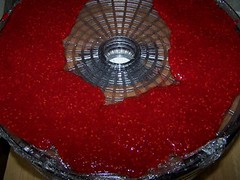
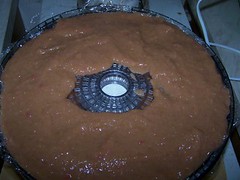
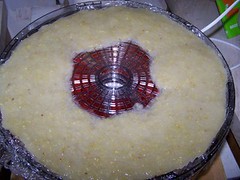
Step 6 Dehydrate
Turn on your dehydrator (you can do this on baking sheets in a very cool oven if you prefer). I find this will take 7-10 hours to dry out so leave plenty of time
Keep going till you have a stiff but bendy sheet of leather. It will be about a third of the original height

Peel the leather carefully off the backing sheet
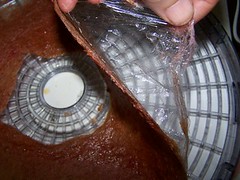
Step 7 prepare rolls
Cut your fruit leather into strips (I use scissors) and roll each strip up for convenient storage
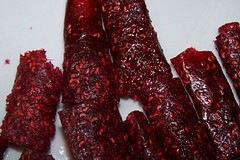
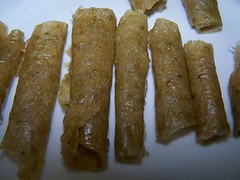
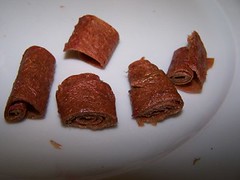
Step 8 cool and store
I leave the rolls to cool on a plate in the fridge for 24 hours I find storing them warm leads to condensation
After 24 hours I put mine in a plastic tub and keep in the fridge (not really necessary). I shove a mixed handful in a ziplock for day walks or take the whole tub as trail snacks and deserts for longer trips. You can of course add water and turn them back into a sort of pie filling or hot desert
Red
Before you start, line the trays of your dehydrator unless you have specialist leather trays. The fruit will drip through the mesh of open trays. I use microwaveable cling film but aluminium foil would work I should think. Make sure you make holes where all the air vents should be.
Step 1 gather your fruit.
For each tray of my dehydrator I need about a litre (quart) of fruit clearly for something like rhubarb this needs to be chopped. So step one is a wander round the veg patch and see whats in surplus
Rhubarb

Raspberry

Gooseberry

Step 2 Prepare the fruit
Its a good idea to was all the gathered fruit as the low temperatures we will use may not kill any nasties. Ultimately we will be putting all the fruit through a blender but we need to get it soft if it isnt already. A wash will suffice for the raspberries but the rhubarb needs to be chopped into ½ slices

And the goosegogs topped and tailed

Step 3 soften if necessary
The harder fruits need to be softened before pureeing. The raspberries need nothing but the gooseberries and rhubarb need to be put into a pan with a TINY amount of water (less than a quarter cup) and heated gently just until they are soft
One softened if necessary put your fruit into a blender. If you dont have a blender you can crush the fruit with a fork in a mixing bowl. I add two tablespoons of honey to each litre of fruit I find this helps in bind into a good leather. Others use apple with soft fruit since the pectin helps the leather set either is good.



Step 4 puree
If you have a blender, slap the lid on and give the fruit a good whiz up. If not, use a fork back against the side of the bowl. You are going for porridge like consistency here



After this, if you want to remove seeds and pips, push the puree through a sieve with the back of a spoon. I like the seeds in so I dont bother but its up to you
Step 5 load dehydrator
Dont forget to ensure you have prepared your dehydrator trays with a covering if they are the mesh type.
Using a palette knife or spoon, spread you puree evenly over the trays. Aim to go no more than ¼ thick or youll be drying the stuff till the next ice age
Dont get the puree too near the air holes as it will spread a bit and you dont want it dripping through the holes



Step 6 Dehydrate
Turn on your dehydrator (you can do this on baking sheets in a very cool oven if you prefer). I find this will take 7-10 hours to dry out so leave plenty of time
Keep going till you have a stiff but bendy sheet of leather. It will be about a third of the original height

Peel the leather carefully off the backing sheet

Step 7 prepare rolls
Cut your fruit leather into strips (I use scissors) and roll each strip up for convenient storage



Step 8 cool and store
I leave the rolls to cool on a plate in the fridge for 24 hours I find storing them warm leads to condensation
After 24 hours I put mine in a plastic tub and keep in the fridge (not really necessary). I shove a mixed handful in a ziplock for day walks or take the whole tub as trail snacks and deserts for longer trips. You can of course add water and turn them back into a sort of pie filling or hot desert
Red




